|
|||||||
| Toward the end of my plenary talk at the 2002 meeting of the Colloquium on Violence and Religion on June 5-8, 2002 at Purdue University (I discussed this conference in a previous issue of the LSS Newsletter), a man in the audience asked, “Do you think war is an addiction?” I said perhaps it is.
On the way out of the auditorium, I exchanged a few words with Bob Hall (photo below right) about his comment. Bob, it turned out, was a popular speaker on college campuses, focusing his talks on the theme of “Nonviolent Sexuality” (the brochure he used at the time is here). His firm was “Learning to Live with Conflict.” We had a pizza together and began a conversation that would last for several years. He believed my ideas were important, and deserved a wide audience. He wanted to bring my theories (and me) out onto the public stage. So a new phase of my career began. Prior to meeting Bob, conveying my research and findings took the form of presenting papers at academic conferences. Below is a summary of my years on the road, 1988-2002. |
|||||||
| PLEASE SCROLL DOWN THE PAGE TO VIEW PHOTOS OF ME WITH COLLEAGUES AT CONFERENCES |
|||||||
It began innocently with this first conference, then with two more in 1989, and a few more in 1990 and 1991. Slowly, things began to pick up steam. It’s not clear if I was going to conferences in order to have the opportunity to present papers (then decided, what-the-hell, why not do a book exhibit), or if I was going to meetings to organize book exhibits (and then decided, what-the-hell, why not present a paper). In any case, the business and scholarly dimensions evolved hand in hand. Having studied as a young man with Norman O. Brown, Peter Berger and Leslie Fiedler, there was no way I could extricate myself from my obligations as an author and scholar—even though I had abandoned a teaching career many years before (after receiving my PhD in Social Psychology and having been promoted to the position of Assistant Professor of Behavioral Science at a college in New York City). I earned a living by organizing book exhibits—this enabled me to attend conferences, to present papers and to appear on panels. I believed I’d made important discoveries on the psychology of political violence. I wanted to share these ideas, to interact with colleagues, and to see what was going on in the academic world. At the same time that I was organizing book exhibits and presenting papers (my partner, Mei Ha Chan was nearly always with me), I sold books I'd authored at each meeting (I’d published three by then). This was my life for many years: traveling around the country (finally getting out of Manhattan), visiting hotels, setting up book exhibits, speaking with colleagues, and selling books (and yes, having coffee and attending receptions). Looking back at the period July 1998 through June 2002, I count 50 presentations that I gave. I attended conferences on political psychology, psychoanalysis, anthropology, holocaust studies, and sociology. I had conversations with some of the finest scholars and professionals in each field (and often sold books to them), including Otto Kernberg, James Grotstein and Joyce McDougall in psychoanalysis; Eric Wolf and Richard Lee in anthropology, James Glass, Jerry Post and Vamik Volkan in political psychology; Omer Bartov and Daniel Goldhagen in Holocaust studies; and many others. I was invited to give Plenary Talks, for example at the Annual Conference on the Holocaust at Millersville University (1998), at a meeting of the Society for Psychological Anthropology (in 1999), and at the Colloquium for Violence and Religion (in 1999 and again in 2002). Still, attending conferences was an arduous way of presenting my research and establishing myself as a theorist. An average of 25 people attended each talk, which meant approximately 1240 people had heard me speak during those 14 years (an average of 90 people each year). Was there a way to reach a wider audience?
|
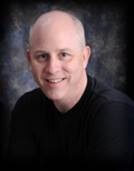
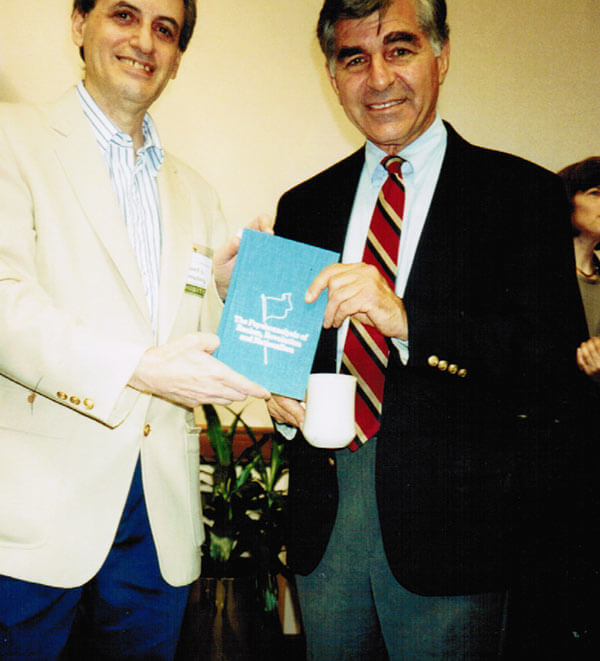
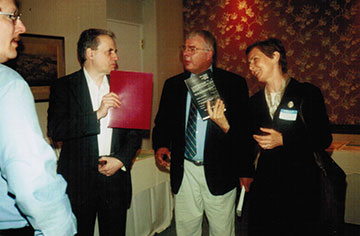 20th Annual Holocaust Conference at Millersville University, April 2, 2000. Meeting Director Professor Jack Fischel is at the center. I’ve just presented a copy of my Hitler’s Ideology to Ernestine Schlant-Bradley (after she’d attended my presentation). Her husband Bill was running for the Democratic nomination for President. I advised her against it.
20th Annual Holocaust Conference at Millersville University, April 2, 2000. Meeting Director Professor Jack Fischel is at the center. I’ve just presented a copy of my Hitler’s Ideology to Ernestine Schlant-Bradley (after she’d attended my presentation). Her husband Bill was running for the Democratic nomination for President. I advised her against it.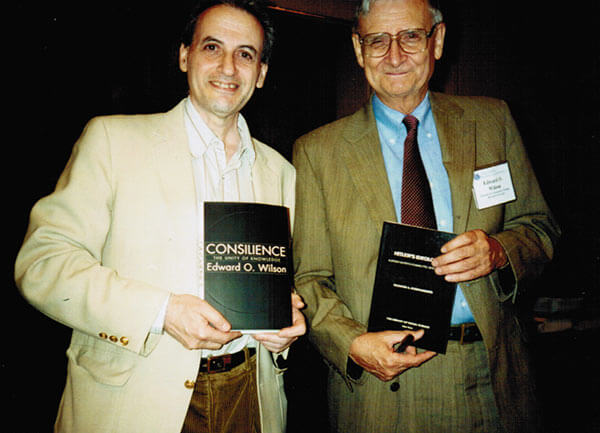 Meeting of the Association for Politics & the Life Sciences in Boston, September 3-6, 1998. Library of Social Science did a book signing for keynote speaker Edward O. Wilson. He’s holding my book and I’m holding his. I presented a paper, “The German Body Politic and the Jewish Disease: Genocide as an Immunological Fantasy.”
Meeting of the Association for Politics & the Life Sciences in Boston, September 3-6, 1998. Library of Social Science did a book signing for keynote speaker Edward O. Wilson. He’s holding my book and I’m holding his. I presented a paper, “The German Body Politic and the Jewish Disease: Genocide as an Immunological Fantasy.”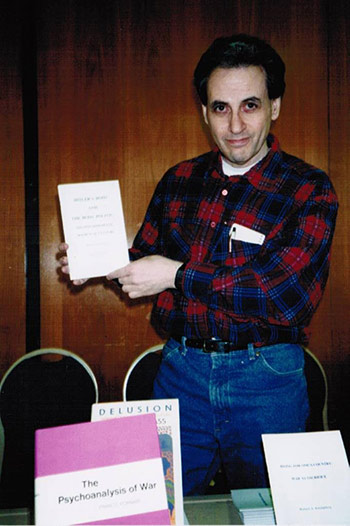 Not sure which meeting this was. I’m holding my pamphlet, Hitler Body and the Body Politic. Another pamphlet Dying for One’s Country: War as Sacrifice is on the right. Before the Internet, I’d print copies of these miniature books and take them to conferences—so that people could keep up with my thinking (printed 200 copies of each pamphlet and sold every one).
Not sure which meeting this was. I’m holding my pamphlet, Hitler Body and the Body Politic. Another pamphlet Dying for One’s Country: War as Sacrifice is on the right. Before the Internet, I’d print copies of these miniature books and take them to conferences—so that people could keep up with my thinking (printed 200 copies of each pamphlet and sold every one).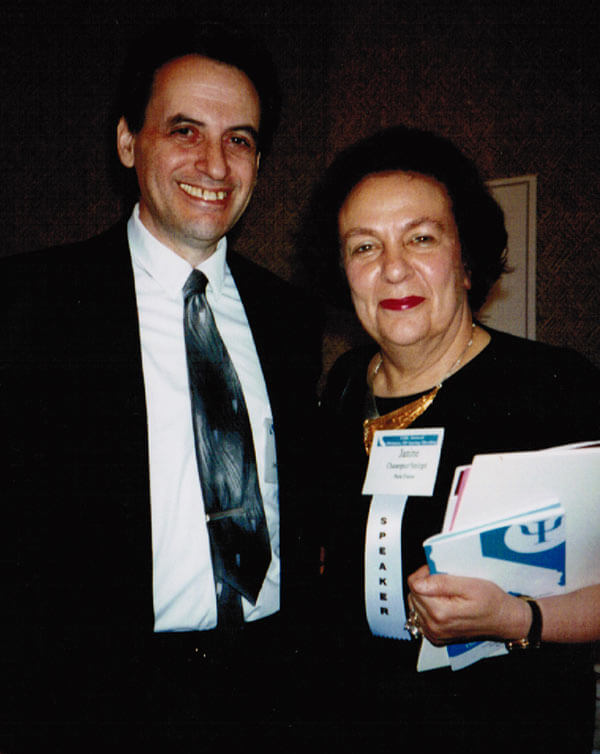 Meeting of Division 39 of the American Psychological Association, April, 1995, Santa Monica, California. I’m with Janine Chasseguet-Smirgel after she’d won an award. This world-renowned psychoanalyst often consulted with me whenever she came to Manhattan—to keep up with the latest research on Nazism.
Meeting of Division 39 of the American Psychological Association, April, 1995, Santa Monica, California. I’m with Janine Chasseguet-Smirgel after she’d won an award. This world-renowned psychoanalyst often consulted with me whenever she came to Manhattan—to keep up with the latest research on Nazism.